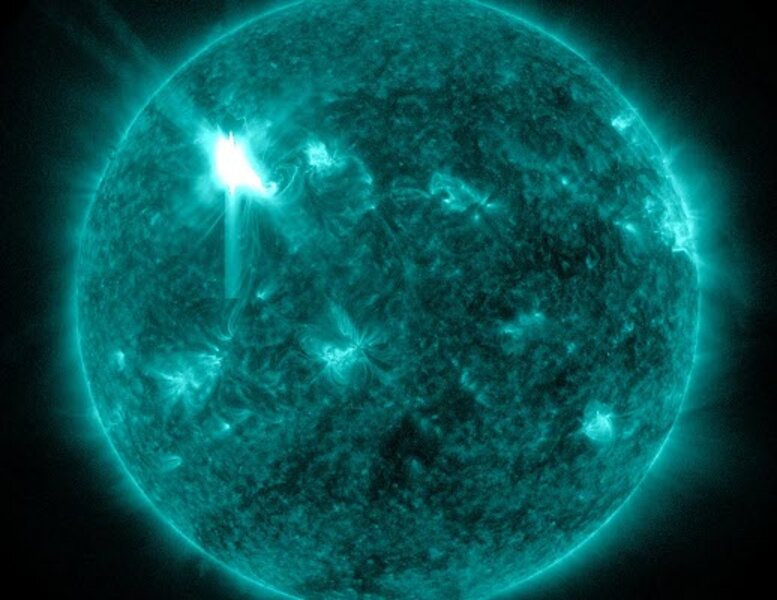Solar flare races towards Earth, expected to cause disruptions to Earth's magnetic field
Loading...
Earth's magnetic field is about to be shaken like a snow globe by the largest solar storm in five years.
After hurtling through space for a day and a half, a massive cloud of charged particles is due to arrive early Thursday and could disrupt utility grids, airline flights, satellite networks and GPS services, especially in northern areas. But the same blast also could paint colorful auroras farther from the poles than normal.
Scientists say the storm, which started with a massive solar flare early in the week, is growing as it races outward from the sun, expanding like a giant soap bubble. When it strikes early Thursday, the particles will be moving at 4 million mph (6.4 million kph).
"It's hitting us right in the nose," said Joe Kunches, a scientist for the National Oceanic and Atmospheric Administration in Boulder, Colorado.
Astronomers say the sun has been relatively quiet for some time. And this storm, while strong, may seem fiercer because Earth has been lulled by several years of weak solar activity.
The storm is part of the sun's normal 11-year cycle, which is supposed to reach peak storminess next year.Solar storms do not harm people, but they do disrupt technology. And during the last peak around 2002, experts learned that GPS was vulnerable to solar outbursts.
Because new technology has flourished since then, scientists could discover that some new systems also are at risk, said Jeffrey Hughes, director of the Center for Integrated Space Weather Modeling at Boston University.
A decade ago, this type of solar storm happened a couple of times a year, Hughes said.
"This is a good-size event, but not the extreme type," said Bill Murtagh, program coordinator for the federal government's Space Weather Prediction Center.
The sun erupted Tuesday evening, and the most noticeable effects should arrive here between 1 a.m. and 5 a.m. EST Thursday, according to forecasters at the space weather center. The effects could linger through Friday morning.
The region of the sun that erupted can still send more blasts Earth's way, Kunches said. He said another set of active sunspots is ready to aim at Earth right after this.
"This is a big sun spot group, particularly nasty," NASA solar physicist David Hathaway said. "Things are really twisted up and mixed up. It keeps flaring."
Storms like this start with sun spots, Hathaway said.
Then comes an initial solar flare of subatomic particles that resemble a filament coming out of the sun. That part already hit Earth only minutes after the initial burst, bringing radio and radiation disturbances.
After that comes the coronal mass ejection, which looks like a growing bubble and takes a couple of days to reach Earth. It's that ejection that could cause magnetic disruptions Thursday.
"It could give us a bit of a jolt," NASA solar physicist Alex Young said.
The storm follows an earlier, weaker solar eruption that happened Sunday, Kunches said.
For North America, the good part of a solar storm, the one that creates more noticeable auroras or Northern Lights, will peak Thursday evening in North America. Auroras could dip as far south as the Great Lakes between Canada and the United States or lower, Kunches said, but a full moon will make them harder to see.
Auroras are "probably the treat we get when the sun erupts," Kunches said.
Still, the potential for problems is widespread. Solar storms have three ways they can disrupt technology on Earth: with magnetic, radio and radiation emissions. This is an unusual situation, when all three types of solarstorm disruptions are likely to be strong, Kunches said. That makes it the strongest overall since December 2006.
That means "a whole host of things" could follow, he said.
North American utilities are monitoring for abnormalities on their grids and have contingency plans, said Kimberly Mielcarek, spokeswoman for the North American Electric Reliability Corp., a consortium of electricity grid operators.
In 1989, a strong solar storm knocked out the power grid in Quebec, causing 6 million people to lose power.
Solar storms also can make global positioning systems less accurate and cause GPS outages.
The storm could trigger communication problems and additional radiation around the north and south poles — a risk that probably will force airlines to reroute flights. Some already have done so, Kunches said.
Satellites could be affected, too. NASA spokesman Rob Navias said the space agency is not taking any extra precautions to protect astronauts on the International Space Station from added radiation.







